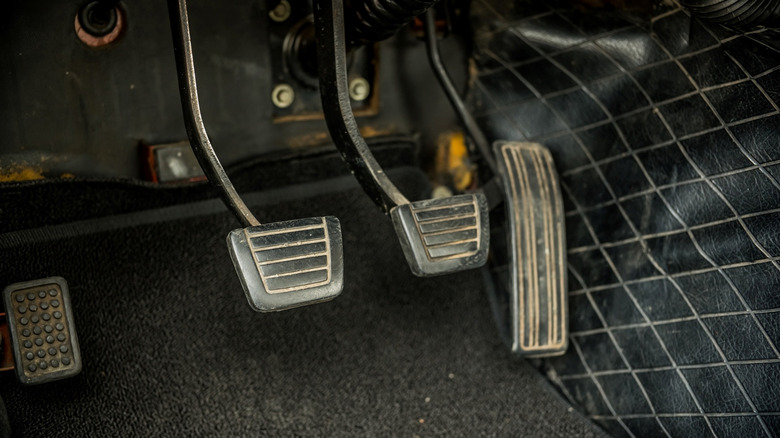Why Do Some Old Cars Have Four Pedals? Here's What They're For
Once upon a time, automobiles came with not two or even three pedals, but four. In a previous article, we discussed the odd little button on the floor of classic cars, but that's not what we're talking about here. No, this was a literal fourth pedal that once occupied the left side of the driver's side floorboard. A lot going on, to be sure.
Everyone knows what the gas (far right) and brake (to the immediate left of the gas) pedals do. If you have a manual transmission, the clutch pedal is the farthest one to the left. What would a fourth pedal even manipulate? If this was April Fool's Day, we might try and take you for a ride (pardon the pun) by saying it's a Fast & Furious-style boost pedal to activate the car's supercharger or maybe a clever way to increase the clutch's difficulty level like some in-car skills test. It's not April Fool's, and that's not what it was for.
Before there was the electronic parking brake found on today's modern cars, and before there was your standard pull-lever handbrake sitting in the center console, there was the good old-fashioned push pedal parking brake. Yes, that fourth pedal was what the handbrake used to be. Sometimes you could find the word "Park" stamped on the rubber itself as a friendly reminder to not mistake it for the clutch — which would be very bad, so you might assume that's why it went from being a foot-operated pedal to a safer hand-operated brake. Turns out, not really.
No room for so many pedals
The emergency brake was designed as a backup should your car's primary brake system conk out. All vehicles manufactured on or after July 1, 1973, were required to have such a system. The fourth pedal was located to the far left, usually up against the left panel in the footwell. The driver would press down on it until it clicked and pull a lever just above the pedal to disengage it. However, in some cases, you actually stepped on the pedal again to disengage it.
Today's modern cars are equipped with bucket seats, but that was not the case for the first sixty or so years of the American automobile's life. Back in the day, family sedans came standard with benches, as they provided more seating and were much easier and far cheaper to make. Many people who grew up in the 1960s and '70s — when seat belts were a suggestion and not a rule — fondly remember riding around in (and even owning) cars with bench seats.
As car designs evolved, the "cool" American station wagons and muscle cars that once ruled the road grew smaller as fuel consumption and MPGs became more important to consumers. As a byproduct, footwells grew smaller, bench seats became buckets, and the center console — replete with features and amenities — became commonplace. With no room left at the driver's feet, the old-school parking pedal morphed into the handbrake in the center console. Now, even that's becoming obsolete, with only 9% of new vehicles including them.
